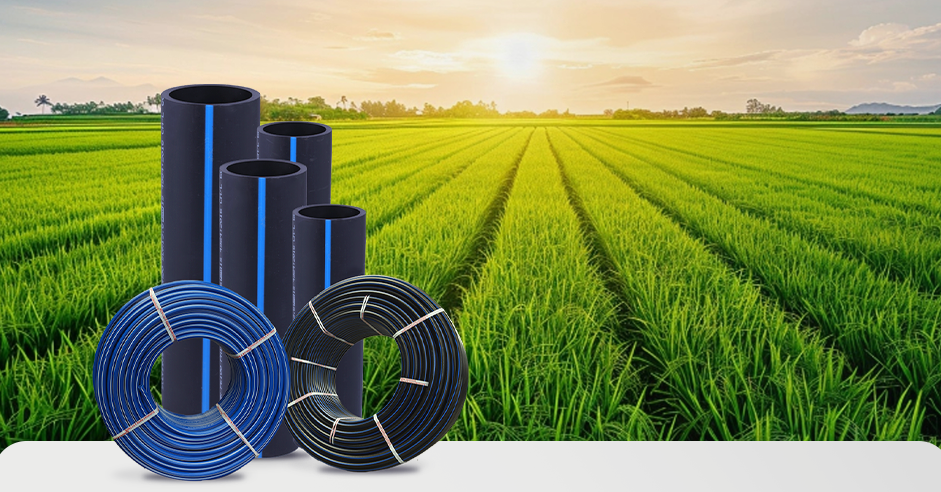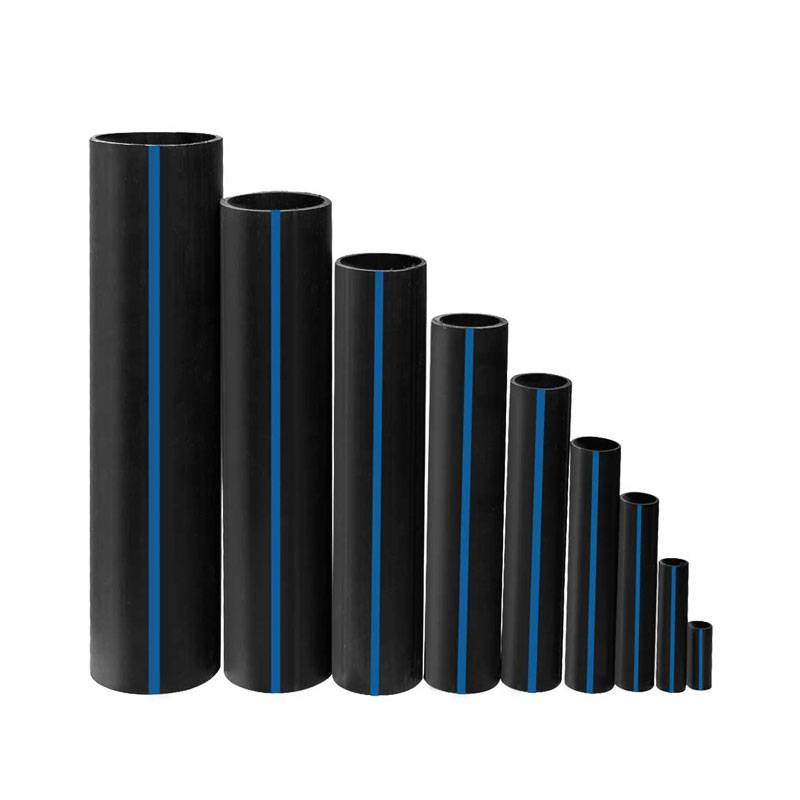Where to Find hdpe pipe in stock Midland TX for Fast Turnaround
Explore the Production Refine Behind High-Quality HDPE Pipeline and Its Applications
The production process of premium HDPE pipes is complex and systematic. It starts with the selection of basic materials that improve efficiency. Following this, ethylene goes through polymerization to develop resin, which is after that formed with extrusion. Quality control is paramount, guaranteeing that the final product fulfills stringent standards. However, the trip of HDPE pipes doesn't end with manufacturing. Their applications across various markets expose a wider importance worth analyzing.
Recognizing HDPE: Characteristics and Advantages

High-density polyethylene (HDPE) is a flexible polycarbonate recognized for its toughness and resistance to various ecological elements. This material shows outstanding tensile strength, making it ideal for requiring applications. Its low-density structure adds to a lightweight item, helping with convenience of dealing with and installment. HDPE additionally showcases exceptional resistance to chemicals, which reduces destruction when exposed to extreme compounds.
The product's reduced moisture absorption additionally improves its long life, making it perfect for usage in pipes and storage space containers. Additionally, HDPE is immune to ultraviolet (UV) radiation, guaranteeing that products preserve their stability also when revealed to sunshine. Furthermore, its adaptability permits the development of elaborate forms without endangering strength. The eco-friendly nature of HDPE, typically stemmed from recycled products, includes in its charm, advertising lasting techniques in production. Overall, these residential properties and advantages make HDPE a favored option for different industrial and consumer applications.
Basic Material Selection for HDPE Production
The choice of basic materials for HDPE manufacturing is necessary to confirm the last item meets the desired requirements and top quality criteria. High-density polyethylene (HDPE) is largely produced from polymerized ethylene, stemmed from nonrenewable fuel sources such as all-natural gas or crude oil. The top quality of these feedstocks greatly affects the mechanical and thermal homes of the final HDPE.
Ingredients likewise play a significant role in boosting HDPE's efficiency, including antioxidants, UV stabilizers, and colorants, which boost longevity and resistance to environmental elements. The selection procedure need to consider not only the chemical make-up of the raw materials yet also their processing features to ensure efficient production.
In addition, the sourcing of raw products must prioritize sustainability and conformity with ecological guidelines, as responsible methods are crucial in today's market. Ultimately, mindful resources selection lays the foundation for generating premium HDPE pipelines suitable for varied applications.
The Extrusion Refine: Shaping HDPE Pipeline
The extrusion process plays an essential role in forming HDPE pipelines, starting with thorough material preparation methods that assure optimal circulation and uniformity. Equally vital is the layout of the die, which directly influences the last measurements and surface area quality of the pipe. Together, these variables contribute substantially to the performance and top quality of HDPE pipe production.
Product Prep Work Strategies
Efficient production of HDPE pipes begins with precise product preparation methods, especially the extrusion procedure. Throughout this stage, high-density polyethylene material is initial dried out to remove moisture, guaranteeing excellent circulation characteristics. The material is after that fed right into the extruder, where it goes through home heating and melting, changing into a thick state. This home heating procedure is thoroughly regulated to keep the material's integrity and performance. The molten HDPE is required with a die, shaping it right into a continuous pipe form. Proper temperature level management throughout extrusion is necessary, as it straight impacts the material's residential or commercial properties and the final product quality. Once formed, the HDPE pipeline is cooled down and cut to specified lengths, all set for succeeding handling and applications.
Die Style Value
Precision in die layout plays a vital function in the extrusion process of HDPE pipelines. The die acts as the final shaping device, straight influencing the pipeline's dimensions, wall density, and surface coating. A well-designed die guarantees uniform product flow, lowering flaws such as irregularities and vulnerable points. The geometry of the die have to be enhanced to suit the certain residential or commercial properties of HDPE, including its thickness and thermal habits during extrusion. In addition, the cooling price of the material as it passes with the die can noticeably impact the pipeline's structural stability. Investing in sophisticated die technology is crucial for makers intending to produce premium HDPE pipelines that meet market criteria and consumer assumptions.
Quality Control Actions in HDPE Manufacturing
Although different aspects affect the high quality of HDPE pipeline manufacturing, effective quality control steps are important to ensure consistency and reliability in the end product. Key quality control methods consist of extensive material evaluation, confirming that the raw polyethylene fulfills well-known criteria for purity and density. During the extrusion process, parameters such as temperature, stress, and cooling time are carefully monitored to keep dimensional accuracy and structural honesty
In enhancement, post-production screening is necessary; makers typically conduct hydrostatic tests to evaluate the pipe's toughness and resistance to pressure. Aesthetic inspections for surface flaws additionally improve quality control. Qualification from appropriate requirements companies, like ASTM or ISO, supplies an additional layer of trustworthiness. By applying these extensive quality assurance steps, producers can minimize flaws, boost performance, and ensure that the HDPE pipelines meet the certain requirements of different applications, ultimately bring about customer fulfillment and rely on the item.
Applications of HDPE Pipe Throughout Industries
HDPE pipelines are utilized across different sectors because of their durability and flexibility. In water circulation systems, they guarantee effective distribution, while in wastewater monitoring, they provide reputable remedies for waste transport. Additionally, agricultural irrigation networks gain from HDPE's resistance to deterioration and flexibility, making it an optimal option for modern-day farming techniques.

Water Circulation Equipments
A significant number of industries depend on high-density polyethylene (HDPE) pipes for effective water circulation systems. Recognized for their toughness and resistance to corrosion, HDPE pipes are commonly used in metropolitan supply of water networks, farming watering, and commercial applications. Their light-weight nature helps with very easy handling and installation, reducing labor costs and time. Additionally, HDPE pipes can suit numerous stress degrees, making them ideal for both reduced and high-pressure systems. hdpe pipe in stock Midland TX. The flexibility of the material permits seamless combination into existing infrastructure, minimizing the need for comprehensive excavation. HDPE's resistance to chemical leaching warranties that the water delivered continues to be risk-free and tidy, making it a perfect option for keeping the quality of drinkable water throughout various industries.
Wastewater Administration Solutions
Effective water distribution systems likewise lead the means for innovative wastewater monitoring remedies, where high-density polyethylene (HDPE) pipes play a considerable duty. Popular for their longevity and resistance to corrosion, HDPE pipes are suitable for moving wastewater in various setups. Their adaptability enables very easy installment in complex atmospheres, lessening the requirement for considerable excavation. In addition, HDPE's smooth interior surface area minimizes friction, improving flow prices and efficiency. These pipelines are additionally immune to chemical leaching, making certain that contaminants do not compromise the surrounding environment. Industries, municipalities, and treatment facilities progressively count on HDPE pipelines for their integrity and long life, making them a favored option for modern wastewater management systems. This flexibility emphasizes the critical importance of HDPE pipelines throughout countless applications.
Agricultural Irrigation Networks
Agricultural irrigation networks profit considerably from making use of high-density polyethylene (HDPE) pipes, which provide efficient and reliable water distribution to plants. HDPE pipelines are light-weight, making them easy to transport and mount, while their versatility permits various arrangements in diverse surfaces. These pipelines demonstrate excellent resistance to deterioration, chemicals, and UV radiation, guaranteeing resilience in harsh farming atmospheres. Additionally, their smooth indoor surface lessens friction loss, enhancing water circulation and decreasing power prices connected with pumping. The long life of HDPE pipelines, frequently exceeding 50 years, adds to lower maintenance and substitute costs. Farmers increasingly count on HDPE pipes to improve watering performance and advertise lasting farming practices, eventually leading to boosted plant yields and source preservation.

Future Fads in HDPE Pipeline Technology
As the demand for sustainable and efficient facilities expands, developments in HDPE pipeline innovation are poised to transform different sectors. Emerging fads include the combination of clever technologies, such as sensing units and IoT capabilities, which promote real-time monitoring of pipe conditions, minimizing maintenance costs and stopping leakages. Additionally, the development of advanced manufacturing methods, such as 3D printing, is making it possible for the production of complicated, personalized pipeline layouts that deal with certain project requirements.
In addition, the concentrate on recycling and round economic climate techniques is driving the innovation of HDPE pipes made from recycled materials, boosting sustainability. Boosted jointing techniques, such as electro-fusion and mechanical installations, are likewise improving installation efficiency and integrity. Ultimately, the expanding emphasis on ecological guidelines is pushing producers to adopt greener manufacturing procedures, making sure that HDPE pipes not only fulfill industry standards yet likewise promote a more sustainable future for facilities development.
Regularly Asked Concerns
How Does HDPE Contrast to Other Plastic Products?
HDPE surpasses many various other plastic materials relating to sturdiness, chemical resistance, and versatility. Its low thickness and high tensile strength make it suitable for various applications, typically surpassing choices in both performance and durability.
What Are the Ecological Impacts of HDPE Manufacturing?
The environmental influences of HDPE production include greenhouse gas exhausts, energy intake, and prospective contamination from manufacturing processes. Additionally, inappropriate disposal can bring about soil and water contamination, raising worries concerning long-lasting eco-friendly results.
Can HDPE Piping Be Recycled?
Yes, HDPE pipelines can be reused. Many facilities accept utilized HDPE for handling, changing it right into brand-new items. This recycling adds to sustainability get more info initiatives, reducing plastic waste while conserving resources and power in the manufacturing cycle.
What Is the Lifespan of HDPE Pipeline?

Just How Do Temperature Level Variations Impact HDPE Pipe Efficiency?
Temperature variations substantially impact HDPE pipeline efficiency, influencing flexibility and toughness. High temperature levels can lead to softening, while low temperatures might create brittleness, eventually influencing the pipe's toughness and viability for different applications in varied atmospheres.